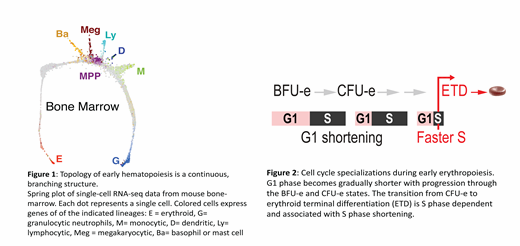The manner by which multipotent hematopoietic progenitors commit to the erythroid lineage, and the subsequent processes that govern early erythroid progenitor development, are not well understood. Part of the challenge for investigating these was the lack of a rigorous strategy for isolating directly from tissue the early erythroid progenitors, which are functionally defined as the cell 'units' that give rise to erythroid colonies (CFU-e) or bursts (BFU-e) in culture. Indeed, the early erythroid trajectory, that starts with multi-potential progenitors and gives rise to BFU-e, CFU-e and to erythroblasts undergoing terminal differentiation, was not fully elucidated. We addressed these gaps using single cell transcriptomics, combined with functional assays that validated computational predictions 1. These showed that early hematopoietic progenitors form a continuous, hierarchical branching structure, in which the erythroid and basophil/mast cell fates are unexpectedly coupled. We delineated a novel flow-cytometric strategy that prospectively isolates CFU-e and BFU-e progenitors with high purity, and in combination with computational predictions, identified novel growth factor receptors that regulate early erythropoiesis. We further discovered that early erythroid development entails profound remodeling of both G1 and S phases of the cycle, resulting in cell cycle specializations that orchestrate the developmental process, including a gradual shortening of G1 during the CFU-e phase, followed by a sharp increase in the speed of S phase during the S-phase dependent activation of the erythroid terminal differentiation program 1-3(Figure 2).
1. Tusi BK, Wolock SL, Weinreb C, et al. Population snapshots predict early haematopoietic and erythroid hierarchies. Nature. 2018;555(7694):54-60.
2. Hwang Y, Futran M, Hidalgo D, et al. Global increase in replication fork speed during a p57KIP2-regulated erythroid cell fate switch. Science Advances. 2017;3:e1700298.
3. Pop R, Shearstone JR, Shen Q, et al. A key commitment step in erythropoiesis is synchronized with the cell cycle clock through mutual inhibition between PU.1 and S-phase progression. PLoS Biol. 2010;8(9).
No relevant conflicts of interest to declare.
Author notes
Asterisk with author names denotes non-ASH members.


This feature is available to Subscribers Only
Sign In or Create an Account Close Modal